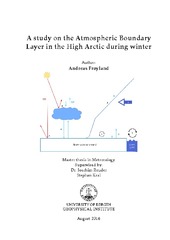A study on the Atmospheric Boundary Layer in the High Arctic during winter
Master thesis
Permanent lenke
https://hdl.handle.net/1956/13147Utgivelsesdato
2016-08-26Metadata
Vis full innførselSamlinger
- Geophysical Institute [1187]
Sammendrag
We investigated the stable boundary layer in Adventdalen by measuring meteorological parameters with Sonic anemometers at two heights, as well as slow response measurements, during a 7 week measurement campaign from February to April 2014. The main drivers of the stability in Adventdalen was found to be the wind speed, the wind direction and the net radiation. Calm conditions with weak SE wind and strong negative net radiations were favorable to get very stable conditions. Such very stable conditions, however, very rarely occurred as the measurement period was characterized by exceptionally mild conditions. Classic MOST represented the fluxes better than MOST using local scales, at least up to ζ ≈ 0.3. The downward heat flux maxima is found at ζ ≈ 0.01, but it is not found to be a good threshold for the transition regime. This could be caused by the lack of observations at higher levels. We found that the Coriolis force had an insignificant influence to the turbulence. The non-dimensional profiles were highly influenced by the choice of vertical gradients, but we found the wind profile to be estimated best using a logarithmic fit to the data. The universal function ϕ_h^G07 represented the calculated non-dimensional h temperature profile well, at all stabilities, while ϕ_m^G07 only represented our calculated m non-dimensional momentum profile adequately up to ζ ≈ 0.2.
